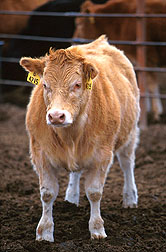Beef Leanness Gene Pinpointed
|
|
Superbly lean—but tender—beef rump roasts may reach more tables when new technology helps cattle breeders turn a possibly undesirable gene into a sure asset.
On a genetic map for cattle, Agricultural Research Service scientists and their colleagues have pinpointed a gene that codes for a form of protein called myostatin. In its usual active form, myostatin puts the brakes on the number of muscle fibers produced in a calf fetus. Another, less common version of the gene produces inactive myostatin.
Researchers now know that two copies of the gene for inactive myostatin are responsible for double muscling—that is, extreme muscularity in the hind quarters of cattle.
Double muscling is considered an undesirable trait from a production standpoint. Sometimes, birth of double-muscled calves must be assisted by such extraordinary means as Cesarean section.
Cattle with only one copy of the gene for inactive myostatin look normal, but their carcasses typically yield about 7 percent more beef that has about 14 percent less overall carcass fat than beef with active myostatin, says Timothy P. Smith. He is a chemist at ARS' Roman L. Hruska U.S. Meat Animal Research Center (MARC) in Clay Center, Nebraska.
After several years of mapping research, MARC scientists had nearly pinpointed the location of the genetic defect causing extremely large muscles—or muscular hypertrophy—in double-muscled cattle to a small segment of bovine chromosome 2. Then, scientists at the Johns Hopkins School of Medicine in Baltimore, Maryland, discovered a gene they named myostatin that increased muscularity in mice.
Putting the two findings together, MARC researchers teamed up with scientists at the Ruakura Agricultural Research Centre in New Zealand and within months were able to show that changes in the bovine myostatin gene cause double muscling. Similar results were reported from a team of European labs. The Johns Hopkins team has also found myostatin genes in pigs, chickens, and turkeys.
Smith and his colleagues at MARC have since developed DNA tests for slightly differing versions of the myostatin gene that are often found in Belgian Blue and Piedmontese cattle breeds. "We hope to see these tests become available for commercial use in the near future," says Smith.
Cattle breeders could obtain test results from blood, semen, or a small sample of a cow's ear to plan sure-bet mating strategies for producing cattle with just one copy of a gene that signals production of inactive or weakly active myostatin. Such cattle would provide the kind of beef today's consumer wants without increasing the risks of difficult calvings, Smith says.
The researchers found that cattle with at least one gene for inactive myostatin produce beef that has less marbling, or intramuscular fat, as well as less extramuscular fat.
Contrary to popular opinion, Smith says, less marbling doesn't always mean less tender. The researchers expect to pinpoint a number of genes that, together, control tenderness.—By Ben Hardin, Agricultural Research Service Information Staff.
This research is part of Animal Germplasm Resources, Conservation, and Development, an ARS National Program described on the World Wide Web at http://www.nps.ars.usda.gov/programs/appvs.htm.
Timothy P. Smith is at the USDA-ARS Roman L. Hruska U.S. Meat Animal Research Center, P.O. Box 166, State Spur 18D, Clay Center, NE 68933; phone (402) 762-4366, fax (402) 762-4390.
"Beef Leanness Gene Pinpointed" was published in the June 1999 issue of Agricultural Research magazine.







